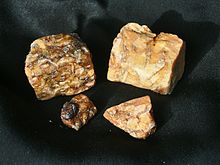Benzoin
As benzoin [ bɛnt͜soe ] or benzoin refers to the resin of various styrax ( Styrax spp. ). A distinction is to be made mainly between the species Siam-Benzoin ( Styrax tonkinensis Craib ) and Sumatra-Benzoin ( Styrax benzoin Dryand. ), As well as Styrax paralleloneurus, which belong to the Storax tree family ( Styracaceae ). The wild evergreen trees ( Styrax tonkinensis ) are harvested in Thailand, Laos , Vietnam and Cambodia , while Sumatran benzoin and Styrax paralleloneurus represent a regionally limited product. The styrax resin of the related storax tree ( Styrax officinalis ) or of sweetgum trees ( Liquidambar spp. ) Must be distinguished from the benzoin resin . Others are the Sumatra species Styrax ridleyanus and Styrax subpaniculatus , as well as Styrax serrulatus from India and Malaysia and the South American species Styrax camporum and Styrax ferrugineus , Styrax argenteus and Styrax warscewiczii (whose resin is called here “estoraqueiro” or “beijoeque”) Styrax tessmannii , Styrax pearcei .
etymology
The Arabic word for benzoin, luban dschawi (لبان جاوي, " incense from Java ") came to Europe through trade relations with Catalonia . With the omission of the first syllable ( bandschawi ) and the change of the first a to e, benjuì was created in Italian, benzoë in Middle Latin .
properties
The smell of the slightly reddish Siam Benzoin is sticky, intensely balsamic, slightly chocolatey and reminiscent of vanilla . The dark yellow Sumatran benzoin looks warmer, significantly creamier and sweeter.
The main ingredients that determine the smell are benzoic acid , cinnamic acid esters and vanillin . In Sumatran benzoin it is coniferyl cinnamate , benzaldehyde and small amounts of styrene and in Siam benzoin coniferyl benzoate , benzoic acid and zinnamyl benzoate .
use
The fragrant benzoin is usually offered in its resin form and is excellent for smoking. In India , benzoin is a component of temple incense mixtures. In the Russian Orthodox Church , it is (and not the resin of the actual frankincense tree) the main component of church incense . The incense paper d'Arménie (Armenian paper) gives off an intense benzoin scent. Benzoin is also used to make perfumes ; it is particularly suitable for oriental and warm fragrance compositions, at the same time it serves as a fixator .
In the Roman Catholic Church , the resin is a component of the balsam oil. This oil is used when the sacrament of the Anointing of the Sick is administered (formerly known as the “Last Unction”).
Benzoic acid is a preservative in the food industry. In Italy, benzoin is used to make orzata syrup.
In musical instrument making (e.g. violin making ) benzoin is a component of violin varnish .
See also
Web links
- Worksheets on fragrance herbalism: Benzoin ( Memento from June 28, 2001 in the Internet Archive )
literature
- Julia Lawless: The Illustrated Encyclopedia of Aromatic Oils. The comprehensive standard work on healing oils and plants (original title: The Illustrated Encyclopedia of Essential Oils. Translated by Karl Friedrich Hörner), Scherz, Bern / Munich / Vienna 1996, ISBN 3-502-15400-7 .
- Dieter Martinez, Roland Hartwig: Pocket Book of Fragrances: A Lexicon from A – Z. Harri Deutsch, Thun / Frankfurt am Main 1998, ISBN 3-8171-1539-3 .
- Susanne Fischer-Rizzi , Peter Ebenhoch (illustrations): Messages to the sky. Application, effects and stories of fragrant incense. AT, Aarau 2001, ISBN 3-85502-875-3 (original edition Munich, Hugendubel 1996, ISBN 3-88034-896-0 ).
Individual evidence
- ↑ Entry on benzoin. In: Römpp Online . Georg Thieme Verlag, accessed on February 9, 2012.
- ^ Jean H. Langenheim: Plant Resins. Timber Press, 2003, ISBN 978-0-88192-574-6 , pp. 347-356. online (PDF; 22.18 MB).
- ↑ A. Dietrich : LUBĀN. In: The Encyclopaedia of Islam . 2nd Edition. Volume 5. Brill, 1986, ISBN 90-04-07819-3 , p. 786 a .

